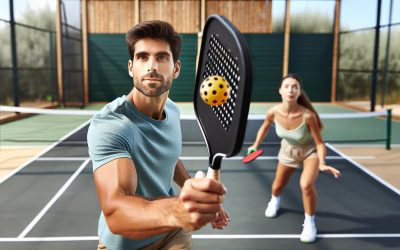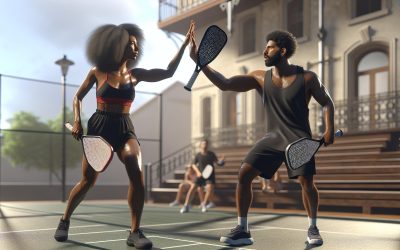Pickleball has taken the sports world by storm, and doubles play is where the action truly heats up. Whether you’re new to the court or looking to sharpen your competitive edge, understanding the best strategies for doubles can be a game-changer. It’s not just about having the right partner; it’s about moving and thinking as one.
From mastering the art of communication to perfecting your positioning, the right strategies can elevate your game from good to unbeatable. Let’s dive into the essentials of pickleball doubles strategies that’ll have you and your partner dominating the court in no time. With these tips, you’ll not only improve your gameplay but also bring a new level of excitement to your matches.
The Importance of Communication in Pickleball Doubles
In the dynamic world of pickleball doubles, effective communication isn’t just beneficial—it’s crucial. Without it, even the most skilled players can find themselves at a disadvantage. This section explores why talking and strategizing with your partner goes a long way in securing wins on the court.
One of the first aspects to consider is the division of the court. Knowing who covers what area ensures players don’t collide or leave parts of the court open for the opponents to exploit. Pre-match discussions about strengths, weaknesses, and preferences are essential. However, it’s the in-game communication that really makes the difference. Simple calls like “mine,” “yours,” or “switch” need to be clear and decisive. These verbal cues help both players stay aligned with the game plan and respond effectively to the fluid nature of play.
But communication in pickleball doubles isn’t just about calling shots. It’s also about providing real-time feedback and encouragement. Celebrating good shots and encouraging a partner after a missed opportunity can bolster morale and maintain a positive atmosphere within the team. This psychological boost is often what separates winning teams from the rest.
Visual signals play a significant role as well. Before serving, partners usually signal to each other to decide on the serving strategy or to plan the next move. This could involve indicating a targeted area on the opponent’s side or planning a particular shot. These non-verbal cues are invaluable in maintaining the element of surprise against opponents and can turn the tide in closely contested matches.
- Pre-Game Planning: Discuss each player’s responsibilities, strengths, and strategies before the game. Establish clear signals for different scenarios.
- During the Game: Keep the lines of communication open with succinct, clear calls. React quickly to your partner’s verbal and non-verbal cues.
- Post-Point Discussion: Briefly discuss what worked and what didn’t after each point to fine-tune your strategy continually.
- Practice Sessions: Use practice sessions not just for physical training but also for improving your communicative synergy.
Mastering Court Positioning for Doubles Success
In competitive pickleball play, mastering court positioning can make a significant difference in the outcome of a game. Doubles teams with a strong understanding of strategic positioning often find themselves at an advantage, able to cover the court effectively and exploit gaps in their opponent’s defense.
The Basics of Effective Positioning
Effective court positioning in doubles pickleball hinges on two main principles: staying parallel to your partner and maintaining an appropriate distance from the net. These fundamentals ensure that players can cover the largest possible area of the court, reducing the chances for opponents to find open spaces for shots.
- Staying Parallel: This means moving in sync with your partner. If one player advances towards the net, the other should do likewise, maintaining alignment across the court. This alignment helps in covering both the left and right sides efficiently.
- Distance from the Net: Ideal positioning involves being close to the net but not so close that lob shots become a constant threat. A general rule is to stand just behind the non-volley zone, allowing for quick volleys and minimizing the effectiveness of opponents’ lobs.
Exploiting the Stack and Switch Strategy
Advanced doubles teams often utilize the “stack and switch” strategy, where both players start on the same side of the court before one crosses over after the serve. This tactic allows teams to put their stronger player in the best possible position to handle volleys and smashes, maximizing their offensive capabilities.
- When to Stack: Utilizing this strategy is particularly useful when one player has a significantly stronger forehand or when trying to exploit an opponent’s weakness.
- Execution: It requires excellent communication and understanding between partners as they need to coordinate their movements precisely to avoid confusion and maintain court coverage.
Practicing Defensive and Offensive Positioning
To excel in competitive play, teams must practice both defensive and offensive court positioning strategies.
- Defensive Positioning: In defensive scenarios, players should position themselves further back in the court, allowing extra time to react to smashes and drives. The key is to anticipate shots and move as a unit to cover the court.
- Offensive Positioning: Conversely, when on the offensive, players should push forward, challenging their opponents with aggressive net play. This aggressive positioning puts pressure on opponents, limiting their shot options.
Utilizing Offensive and Defensive Strategies
In competitive pickleball doubles play, mastering both offensive and defensive strategies is crucial for tipping the scales in one’s favor. These strategies are not just about hitting the ball; they’re about making smart, tactical decisions that put pressure on opponents and exploit their weaknesses.
Offensive Strategies
Offensive play in pickleball doubles hinges on aggression and precision. A key offensive strategy involves the serve and volley. Serving deep forces the receiving team to hit a return from further back, creating an opportunity for the serving team to take control of the net. Controlling the net is paramount in pickleball, as it allows players to hit downward shots, increasing the chances of winning the point.
Another vital component of offensive play is the ‘third shot drop’. After serving, the serving team’s third shot is a softly hit ball that lands in the non-volley zone, or ‘kitchen’, forcing the opponents to hit upwards and allowing the serving team to move to the net. This shot requires finesse and practice but is essential for transitioning from defense to offense.
Defensive Strategies
Defensive play is about positioning, patience, and counter-attacks. One foundational defensive strategy is the ‘lob’. When opponents are aggressively holding the net, a well-placed lob can push them back, allowing the defending team to regain control. It’s a risky move, as a poorly executed lob can easily be smashed, but when done right, it can be highly effective.
Maintaining a solid baseline defense is another critical aspect. Players should focus on returning shots with depth and precision, aiming to keep their opponents at bay and looking for an opportunity to transition to a more offensive position. This involves not only hitting the ball hard but placing it where opponents find it difficult to launch an aggressive return.
The importance of synergy between teammates cannot be overstressed. Good teams communicate effectively, moving as a unit and covering for each other’s weaknesses. This synergy allows them to switch between offensive and defensive plays seamlessly, adapting to the dynamics of the game.
| Strategy Type | Key Tactics |
|---|---|
| Offensive | Serve and volley, Third shot drop |
| Defensive | Lob, Baseline defense |
Capitalizing on Partner’s Strengths and Weaknesses
When it comes to competitive pickleball doubles play, understanding and leveraging the strengths and weaknesses of each partner is crucial. This strategy goes beyond mere coordination; it’s about crafting a game plan that accentuates the positives while mitigating the negatives. By focusing on what each player does best, teams can establish a formidable presence on the court.
The first step is identifying each player’s strengths. For instance, if one partner has a powerful serve and the other excels at net play, they can utilize this combination to put immediate pressure on their opponents. The server can aim for depth and power, forcing a weaker return that the net player can capitalize on. This requires not just skill, but also a deep understanding of each other’s capabilities.
On the flip side, acknowledging weaknesses is equally important. No player is perfect, and by recognizing where each partner may be lacking, the team can adjust their strategy to cover for these shortcomings. If one player struggles with backhand shots, their partner can position themselves to take on more of these hits. This level of adaptation and support is what separates good teams from great ones.
Communication plays a pivotal role in this strategy. Players need to constantly talk to each other, calling shots, and providing encouragement or quick strategy adjustments. This ongoing dialogue ensures that both players are aware of the game plan and can act in unison. Knowing when to switch roles, defend, or go on the offense can often be decided in these brief exchanges.
Practice and observation help in fine-tuning this approach. Teams should spend time both playing together and watching each other play with different partners. This dual approach allows players to not only get used to each other’s playstyles but also to see how their partner reacts to various situations and player types. It’s this depth of understanding that can turn knowledge of strengths and weaknesses into a tactical advantage.
Furthermore, strategic placement based on these analyses can significantly affect the game’s outcome. Teams might decide to align in a way that always allows the stronger server to start the game or to position the better defensive player in a way that they can cover more ground. This strategic placement, guided by an in-depth knowledge of each player’s abilities, can disrupt opponents’ strategies and create openings for scoring.
Incorporating Effective Shot Selection in Doubles Play
In the competitive realm of pickleball doubles play, incorporating effective shot selection becomes a cornerstone of strategic advancement. Teams that master this art not only keep their opponents guessing but also dictate the pace and direction of the game. Developing a keen understanding of when to deploy specific shots can turn the tide in favor of a team, making it an area that demands focus.
Dink shots, characterized by their soft, arched trajectory, are a staple in doubles play. They force opponents to approach the net, setting up potential offensive plays for the executing team. This shot is particularly useful in breaking the rhythm of the opponents, especially those who prefer a faster, power-driven style of play.
Conversely, power shots come into play as an aggressive strategy to overwhelm opponents. Executed with precision and speed, these shots are designed to limit the opponents’ reaction time, creating opportunities for scoring. However, they come with a risk. A poorly executed power shot can easily turn into an advantage for the opponent, so they’re best used judiciously.
An often-underestimated shot in doubles play is the lob. Effective lobs not only push opponents away from the net but also provide a breather for the team to regroup. It’s a strategy that requires both foresight and finesim, as the perfect lob should be just out of reach of the opposing team’s smash.
Strategically integrating drop shots into the game can also disrupt opponents’ positioning. These shots, when placed correctly, can force the opponents to move forward, potentially leaving parts of their court uncovered. It’s a finesse shot that requires practice but, when executed well, can significantly enhance a team’s offensive strategies.
Incorporating these shots into doubles play requires not only individual skill but also a deep sense of partnership. Each player’s shot selection must complement their partner’s positioning and strengths. Here lies the importance of practice and effective communication. The more a team plays together, the more they develop an unspoken understanding of who takes the shot and when.
| Shot Type | Purpose | When to Use |
|---|---|---|
| Dink | Force opponent to the net; disrupt rhythm | Against power-oriented teams |
| Power | Overwhelm opponents; create scoring chances | To exploit weaknesses; with precision |
Conclusion
Mastering the art of pickleball doubles requires more than just skill—it’s about the perfect blend of strategy, communication, and teamwork. Whether it’s choosing between an aggressive serve and volley or a more calculated defensive lob, knowing when and how to switch tactics can make all the difference. Remember, the key to dominating the court lies not just in how well each player performs individually but in how effectively they can combine their strengths, cover each other’s weaknesses, and communicate throughout the game. So grab your partner, hit the court, and put these strategies into play. With practice and a keen sense of observation, you’ll soon find yourselves outmaneuvering opponents and scoring those winning points.













0 Comments